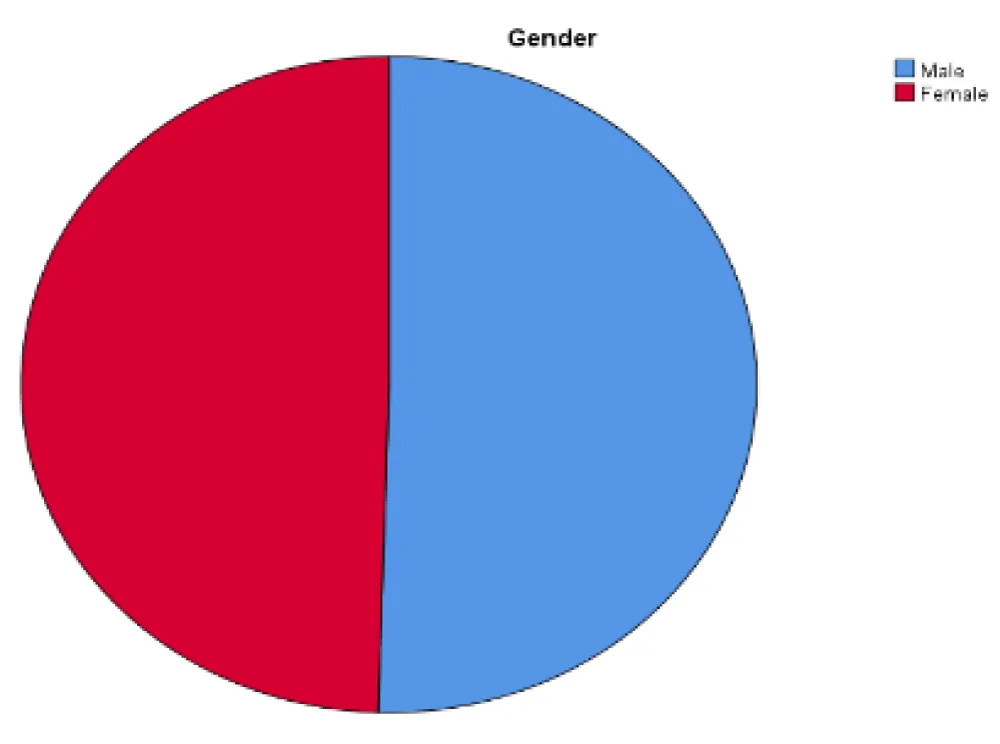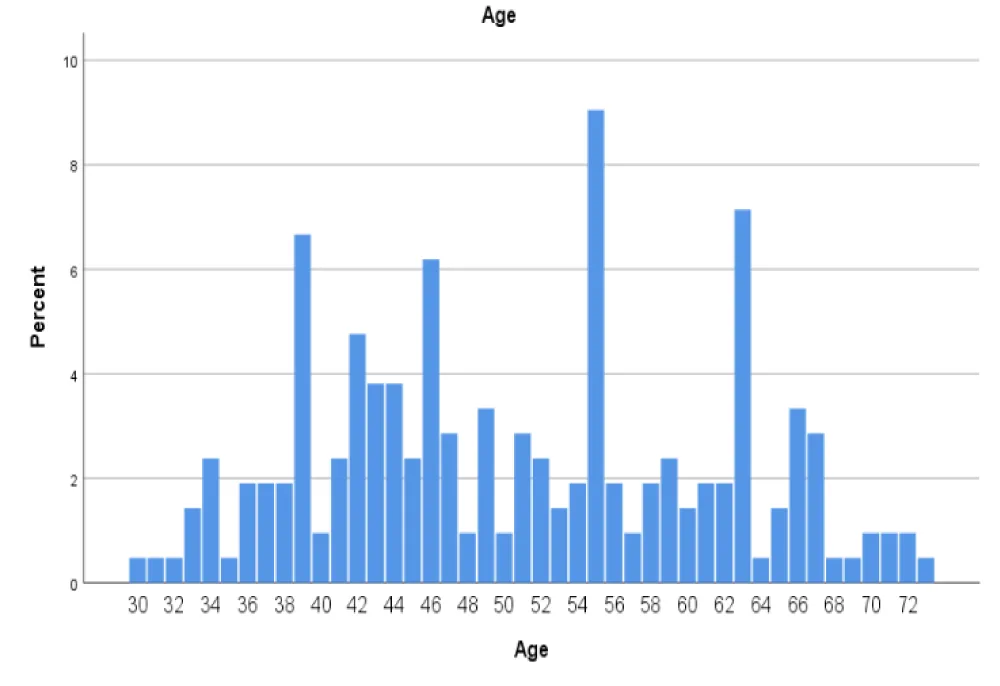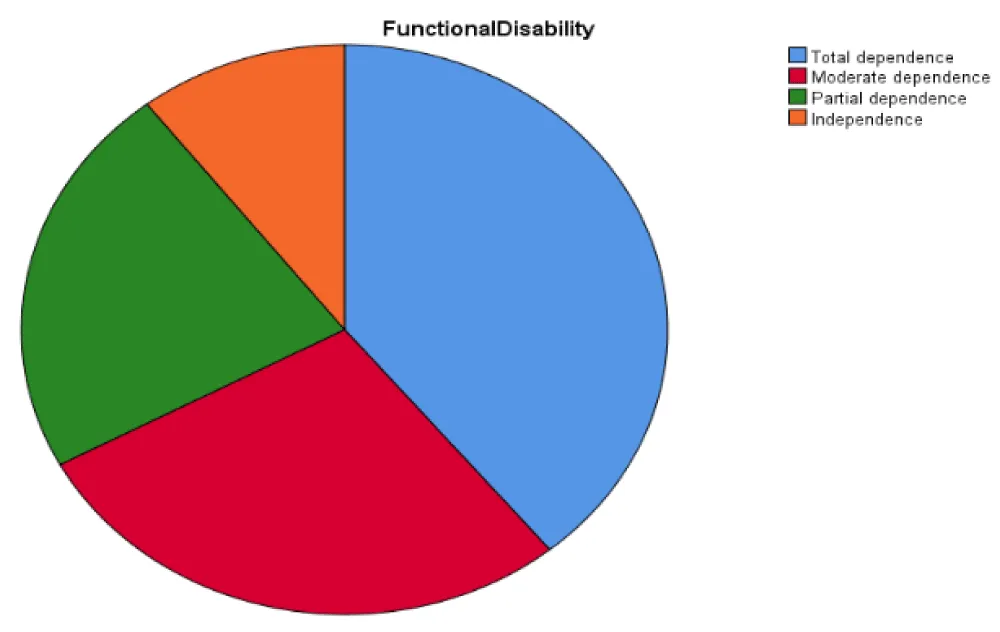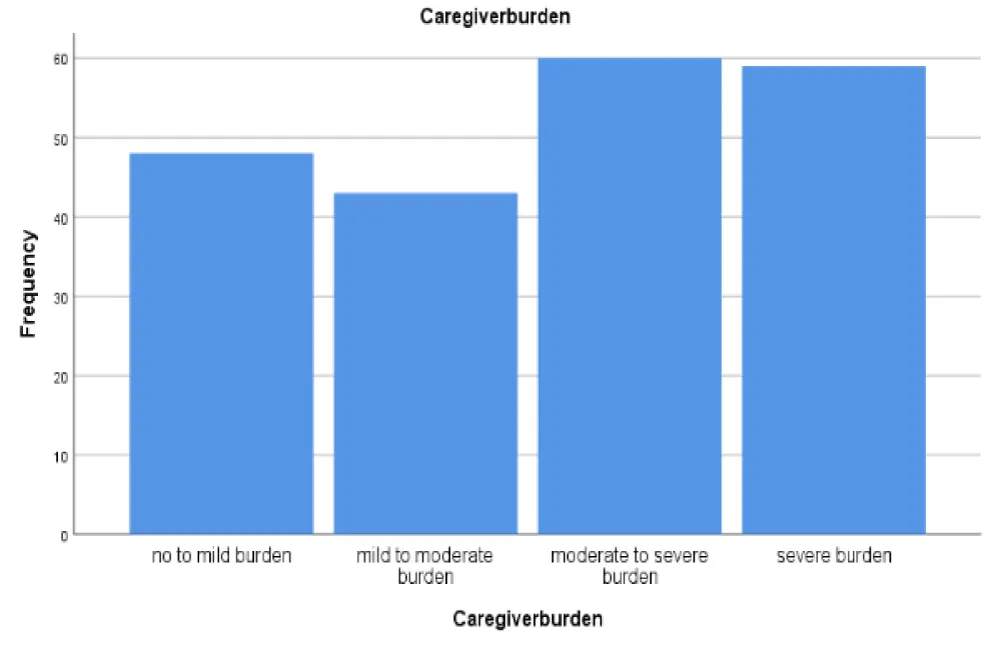Archive of Biomedical Science and Engineering
Association of Caregivers Burden with Functional Disability in Chronic Stroke Survivor in Peshawar: Cross-sectional Study
Muhammad Rahman1, Ayesha2* and Bibi Asma3
1Lecturer in Health Sciences Department, Kohat University of Science and Technology, Kohat, Pakistan
2Physical Therapist at Northwest General Hospital and Research Center, Peshawar, Pakistan
3Physical Therapist, NCS, Peshawar, Pakistan
Cite this as
Rahman M, Ayesha, Asma B. Association of Caregivers Burden with Functional Disability in Chronic Stroke Survivor in Peshawar: Cross-sectional Study. Arch Biomed Sci Eng. 2025;11(1):001-007. DOI: 10.17352/abse.000034Copyright
© 2025 Rahman M, et al. This is an open-access article distributed under the terms of the Creative Commons Attribution License, which permits unrestricted use, distribution, and reproduction in any medium, provided the original author and source are credited.Objective: To determine the association of caregiver burden with functional disability in chronic stroke survivors in Peshawar.
Background: Stroke is a condition that is clinically defined as an acute, focal neurological deficit in function that is caused by vascular injury (hemorrhage, infarction) to the central nervous system. The second common cause of death worldwide and the third most common cause of death and disability combined, according to the Global Burden of Disease 2019 stroke burden estimates. “A person who lives with the patient and is most closely involved in taking care of him/her at home” is the definition of the caregiver. Stroke is a severe and debilitating disease that can disrupt daily life, reduce life expectancy, and lower the quality of life for survivors and their families.
Methodology: It was a cross-sectional study to explore the association between caregiver burden and functional disability in chronic stroke survivors. Data was collected from 210 patients for assessing functional disability through the Functional Independence Measure (FIM) and data was also collected from 210 caregivers for assessing caregiver burden through the Zarit Burden Scale.
Results: This study showed that out of 210 patients, 39.0% had total dependence/complete functional disability, 28.1% had moderate dependence/moderate disability, 22.4% had partial dependence/partial disability, and 10.5% had complete independence/no functional disability. The 210 stroke survivors’ caregivers revealed that 22.9% experienced no to mild burden, 20.5% mild to moderate, 28.6% moderate to severe, and 28.1% severe burden. The study found no significant association between caregiver burden and functional disability among 210 participants, with a p - value of 189.8, which is greater than 0.05.
Conclusion: This study concluded that there is no significant association between Caregiver burden and functional disability among 210 participants, with a p - value of 189.8, which is greater than 0.05.
Introduction
Clinically, stroke is defined as an acute, focal neurological deficit in function that results from vascular injury (hemorrhage or infarction) to the central nervous system [1]. According to the World Health Organization, stroke is defined as the sudden onset of neurological symptoms caused by a disruption in cerebral function that lasts more than 24 hours or results in death [2]. The cause of stroke is typically vascular in nature and does not have any other obvious explanation or consequence. It is most probable that William Cole introduced the term “stroke” to the field of medicine in 1689 through his work titled ‘A Physico-Medical Essay Concerning the Late Frequencies of Apoplexies’. Before Cole, people commonly used the term “apoplexy” to refer to a highly acute, non-traumatic brain injury [2]. Stroke is a major cause of disability and death worldwide. A vascular cause, such as cerebral infarction, intracerebral hemorrhage (ICH), and subarachnoid hemorrhage (SAH), classically characterizes it as a neurological deficit [2]. According to estimates from the Global Burden of Disease 2019 stroke burden, stroke continues to be the second most common cause of death globally and the third most prevalent cause of death plus disability. Experts predict that the global economy will incur costs exceeding $891 billion, equivalent to 1.12% of GDP. Between 1990 and 2019, the global stroke burden increased significantly, with a 70% increase in incident strokes, a 43.0% increase in stroke-related deaths, and a 102.0% increase in prevalent strokes; Lower-income and lower-middle-income countries bear the majority of the burden [3]. Stroke is the second-leading cause of mortality globally, affecting over 5.5 million people annually. Ischemic infractions account for 87% of strokes, with a significant increase between 1990 and 2016, linked to improved clinical therapies and lower mortality rates [4].
In the United States (US), the standardized death rate related to stroke remained high at 36.5 per 100,000 per year in 2014, and the prevalence of stroke is expected to rise in the future due to an ageing population and improving mortality, as previously indicated. Furthermore, although ischemic stroke is typically a disease of the elderly, its prevalence and classic stroke risk factors are on the rise among those between the ages of 15 and 44 [5]. Annually, over 113,000 individuals in the United Kingdom experience a stroke, currently, approximately 1 million people experience stroke. The ageing population and newer therapies leading to higher survival rates primarily contribute to the increase in numbers. Estimates indicate a 34% increase in the annual incidence of strokes in Europe from 2015 to 2035 [6].
Strokes have significantly increased in China over the past 40 years, accounting for the highest number of deaths, years of life lost, and handicap-adjusted life in 2017 [7]. According to a 2013 survey, the age-standardized prevalence of stroke was 1114.8/100,000 people and 246.8/100,000 person-years. The incidence is nearly as high in metropolitan Chinese areas as in developed countries [7].
In Pakistan, a study involving 22,500 individuals revealed that 51.4% of the participants were female, 48.6% were male, 74.66% were from rural areas, and nearly 10.9 percent never attended school. Stroke frequency was 1.2%, with 271 cases [8]. A Pakistani study found a 4.8% prevalence of stroke in the adult Pushtoon community, with 30% of strokes occurring in people under 45, indicating a high rate of young strokes [8]. Blood vessel blockage is the primary cause of stroke, a neurological condition. Cerebral emboli impede the circulation of blood, obstructing the arteries and causing the rupture of blood vessels, leading to hemorrhaging. During a stroke, the cerebral arteries rupture, leading to the abrupt death of brain cells due to a lack of oxygen delivery [4].
Acute Intracerebral Hemorrhage (ICH), a potentially lethal type of acute stroke, presents with various symptoms such as primary intraparenchymal hematoma, Intraventricular Hemorrhage (IVH), and subarachnoid hemorrhage. Many things can cause a Cerebral Venous Thrombosis (CVT), burst congenital vascular abnormalities or dural Arteriovenous Fistulas (dAVF), vasculitis or vasculopathy of the Central Nervous System (CNS), or a hemorrhagic transformation of an ischemic stroke [9]. A cerebral infarction is the main damage that an ischemic stroke does. Due to insufficient blood flow to the brain tissue, vascular occlusion can lead to stroke, with embolism being the most common mechanism. Cardiac problems that frequently result in stroke include atrial fibrillation, valvular heart disease, and cardiomyopathy.
Other infrequent factors contributing to the condition include viral, drug-induced, infiltrative, genetic, or idiopathic causes. An artery-to-artery embolism occurs when a blood clot separates from the walls of a large blood vessel and moves downstream, becoming lodged in smaller blood vessels. Large-vessel disease, which is typically associated with atherosclerotic disease, is another frequent factor. Arterial dissection is a prevalent factor leading to stroke in young patients who do not have any other identifiable risk factors or underlying illnesses that could contribute to the stroke [10]. Small-vessel disease typically results in small, deep strokes, where reduced blood flow extends around blocked arteries and leads to lacunar strokes. Lacunar infarction in common places may result in identifiable clinical manifestations, including the posterior limb, genus, thalamus, and cerebellum [10]. Risk factors of stroke Hypertension, diabetes, and dyslipidemia are significant risk factors for cardiovascular disease, including stroke. The primary modifiable risk factor for stroke is hypertension, and lowering blood pressure can significantly lower the likelihood that a stroke will repeat. Diabetes is a changeable risk factor for ischemic stroke. The primary pathophysiological cause of atherosclerosis, which results in stenosis and vessel and artery blockage and can quickly result in stroke, is dyslipidemia [11].
There are many different types of strokes, making it difficult to identify risk factors for them. Hemorrhagic and ischemic strokes are the two basic types of strokes. Although the proportion of ischemic vs. hemorrhagic strokes varies across populations, ischemic stroke accounts for the majority of strokes (about 80%). Both intraparenchymal and subarachnoid hemorrhagic strokes are possible. Cardio embolic, atherosclerotic, lacunar, other specific causes (dissections, vasculitis, particular genetic disorders, and others), and strokes with no known cause are the categories or “etiologic subtypes” of ischemic stroke [12]. The risk factors for hemorrhagic and ischemic strokes are similar, although there are some noticeable distinctions. Additionally, risk factors for ischemic stroke vary according to the etiology. While it also contributes to atherosclerosis disease, which can lead to ischemic stroke, hypertension is a significant risk factor for hemorrhagic stroke [12]. However, just as hyperlipidemia is a risk factor for coronary atherosclerosis; it is also a particularly significant risk factor for strokes due to extracranial and intracranial blood vessel atherosclerosis. One of the risk factors for a cardioembolic stroke is Atrial Fibrillation (AF) [12].
Stroke-related disability
Neurological disorders have a far higher burden than digestive, respiratory, and malignant diseases combined [13]. In 2005, neurological disorders contributed to 92 million disability-adjusted life years; projections indicate a 12% increase to 103 million by 2030. Among all neurological diseases, cerebral vascular diseases account for over half of the disability-adjusted life years, making them the most prevalent type of these disorders. These predictions suggest that without immediate global action, the neurological load will persist as a significant threat to public health [13]. The long-term effects of a stroke include physical disability, cognitive impairment, tiredness, and mental health problems such as depression and anxiety. As a result, stroke is changing from being a leading cause of death to a chronic illness that affects people in different ways and has an effect on society, health systems, and individuals themselves [14]. Following a stroke, the most common complication is long-term impairment, with 30% of 5 patients unable to walk independently and 50% experiencing hemispheres. Muscle abnormalities resulting from hemi paretic stroke [15]. These abnormalities create a complicated pattern of atrophy and phenotypic change. Abnormal synaptic communication of motor neurons that innervate the muscles may cause structural adaptation alterations in muscle tissue as early as 4 hours following a brain infarction. Between three weeks and six months following a stroke, both paretic and non-paretic limbs experience long-term muscle alterations [15].
Caregiver burden of stroke survivors
“A person who lives with the patient and is most closely involved in taking care of him/her at home” is the definition of the caregiver [16]. “An unpaid person who helps with the physical care or coping with the disease” is another definition of a caregiver [16]. Stroke is a severe and debilitating disease that can disrupt daily life, reduce life expectancy, and lower the quality of life for survivors and their families. Most stroke survivors have varying degrees of disabilities, making them dependent on their caretakers. Patients with severe disability, cognitive impairment, depression, and recurrent stroke were found to be risk factors for stress [17,18]. Carers bear a heavy burden of caregiving due to the negative impact they believe their mental, physical, social, and financial position may suffer due to providing care for their ill relative.
This burden includes difficulties with their physical and mental health, relationships, employment, and financial situation. The negative effects of care burden are linked to worsening general health and quality of life for both cares and patients, as well as increased risk of patient morbidities due to complex reactions to stress and unfavorable perceptions. Stroke patients rely on their care for daily activities, making care a heavy burden [19].
Objective
To determine the association of caregiver burden with functional disability in chronic stroke survivors in Peshawar.
Methods and materials
The study design was an analytical cross-sectional study. The study was conducted at public sector tertiary care hospitals in Peshawar (Khyber Teaching Hospital, Hayatabad Medical Complex, and Lady Reading Hospital Peshawar Medical and Neuro wards). The study proposed time was 6 months after approval of the proposal by the Research Committee of KMU but the target population and data collection was achieved in 3 months. Data was collected from 210 patients for assessing functional disability through the Functional Independence Measure (FIM) and for assessing caregiver burden through the Zarit Burden Scale. The sample size was 210 participants, with a 95% confidence interval and a 50% outcome factor in the population as hypothesised (p). To compute the sample size, we used RAOSOFT’s sample size. Non-probability convenient sampling
Inclusion criteria of the study
Stroke survivor: The stroke patient’s diagnosis was confirmed by MRI and CT as ischemic and hemorrhagic. Both male and female and their caregivers. These survivors were currently undergoing rehabilitation at tertiary care hospitals in Peshawar (Khyber Teaching Hospital and Hayatabad Medical Complex Peshawar), and Chronic stroke patients > 6 months.
Exclusion criteria of the study
Stroke survivor: With any other comorbidity such as traumatic brain injury, or progressive neurological disease (Multiple sclerosis, Parkinson’s disease,). Patients who do not follow verbal and visual commands.
Caregivers: Caregivers who are not able to give consent for the study. Also, if more than one caregiver.
Results
Demographic information
A total of 210 participants were included in the study. Out of the total 210 participants, 106 (50.5%%) participants were males while 104 (49.5%) were females. The mean age of the participants was 50.76 ± 10.50 years (Tables 1,2; Figures 1,2).
Functional disability: The number of patients was 210, out of which 39.0% i.e. (n = 82) were with total dependence/complete functional disability, followed by 28.1% i.e. (n = 59) with moderate dependence/moderate functional disability, 22.4% i.e. (n = 47) were with partial dependence/ partial disability and 10.5% i.e. (n = 22) were with complete independence / no functional disability (Table 3, Figure 3).
Caregiver burden: The number of patients was 210, for assessing caregiver burden data was collected from caregivers of stroke survivors out of which 22.9% i.e. (n = 48) were with no to mild burden, followed by 0.5% i.e. (n = 43) were with mild to moderate burden, 28.6% i.e. (n = 60) were with moderate to severe burden and 28.1% i.e. (n = 59) were with severe burden (Table 4, Figure 4).
Association between caregiver burden and Functional disability
Out of 210 participants, there was no significant association between caregiver burden and functional disability as the p -value is 189.8 which is greater than 0.05(>0.05 shows no association) (Table 5).
Analysis and explanation of correlation findings
Pearson’s correlation coefficient and Spearman’s correlation coefficient:
- Pearson’s correlation coefficient: Pearson’s correlation coefficient of -0.800 suggests a strong negative linear association between the two variables (Table 6).
- Spearman’s correlation coefficient: The interpretation is that the Spearman correlation coefficient of -0.800 indicates a robust negative monotonic association between the two variables (Table 6).
Analysis of risk assessment
The risk estimate value of 0.156 suggests that there is a modest level of risk associated with the observed outcome in the analysis. In the context of a 2x2 table, commonly employed for risk estimation, this indicates that the probability of the outcome happening in one group compared to another is 15.6%. A risk estimate below 1 generally indicates a lower likelihood of the event occurring in the exposed group compared to the non-exposed group (Table 7).
Discussion
Stroke incidence and disability rates have grown significantly in developing countries, regardless of gender [8]. Using the Zarit burden scale and functional independence assessment, this study analyzed data from 210 stroke patients and 210 caregivers to determine the association between functional limitations and caregiver strain. The chi-square test revealed no association between functional disability and care burden. The study found that out of 210 stroke patients, 39.0% had total dependence, 28.1% moderate, 22.4% partial, and 10.5% complete independence. The study found no significant association between carer burden and functional disability, despite the caregivers experiencing varying burdens. Our study’s findings are unreliable to Shamoun and Harris conducted a systematic review. The inclusion requirements led to the selection of seven papers for this systematic review. These studies used numerous measures to evaluate the disability and care burden of stroke patients. All reports revealed a positive association between care load and physical impairment [20]. The irrelevance between my current study and the above-mentioned systematic review may be due to changes in aspects of disability. The systematic review focused on physical disability, while my study prioritized functional disability.
W.J.M. Scholte op Reimer et al.’s study in 1998 found that partners of stroke patients experienced the greatest caring burden in terms of emotions of heavy obligation, ambiguity about patients’ care needs, frequent anxieties, social constraints, and a belief that patients rely solely on their care [21]. The burden of caregiving was evaluated in 115 partners three years after a stroke. The study examined the factors that contribute to the burden, focusing on two main categories: patient characteristics, including sociodemographic status, severity, type, and location of the stroke, disability, handicap, and unmet care needs; and partner characteristics, such as age, gender, disability, quality of life, loneliness, amount of care provided, and unmet care needs. Multiple regression analysis revealed that patients’ disability could partially explain a higher level of burden, but partner characteristics such as emotional distress, loneliness, disability, the amount of informal care provided, unmet demands for psycho-social care, and unmet demands for assistance with daily living primarily explain a higher level of burden. Higher levels of burden are generally associated with spouses’ emotional discomfort rather than the amount of care delivered or the characteristics of the patients. The results of this study differ from mine as they focus on the characteristics of carers, which were strongly positively associated with disability in stroke patients. In contrast, my study concentrated on the characteristics of the carers themselves rather than the amount of care provided or the characteristics of the patients [21].
Serda Em et al.’s study included a cohort of 76 patients who had adequate cognitive abilities and experienced significant physical disability due to hemiplegia resulting from a cerebrovascular accident, along with their carers. Additionally, there were 94 control participants. The patients’ functional state was evaluated using the Barthel Index (BI), the emotional condition of the carers was evaluated using the Hospital Anxiety and Depression Scale (HADS), and their quality of life was examined using the SF36 Health Survey. The study concluded that “Psychological health of cares and association with functional status of stroke patients,” revealed that the mean rates of anxiety and depression among cares were significantly higher than those in the control group. There were notable deficits in their bodily and emotional well-being. The patients’ functional disability correlated with the emotional status of cares and the degree of worry they experienced. As a result, the carer’s assistance may have an impact on the patient’s ability to recover functionally. This study’s findings differ from mine; this could be because they prioritize psychological health over total functional disability [22]. Similar to the results of the results of the above studies, Jen-Wen Hung et al. selected pairs of ischemic stroke in patients and their informal caregivers from a tertiary referral hospital. They interviewed them between 3 and 6 months after the stroke and assessed the level of strain experienced by carers using the Carer Strain Index (CSI), with a score of 7 or more indicating significant carer strain. The study used generalized estimating equations to analyze multiple aspects of caregiver strain. Eighty-nine (89) stroke patients and their carers found that caregivers experienced considerable strain when caring for patients with neurological deficits, severe disabilities, cognitive impairments, and depression. The study also found that carers were more likely to experience strain if they were depressed, had poor health, were unemployed, were changing employment status, or spent more than 3 hours a day caring for patients. Carers also felt a lot of strain, even when receiving assistance from formal caregivers. The study found that severe patient disability, poor cognition, depression, recurrent stroke, changes in caregiver employment status, use of formal cares, and depression were independent predictors of considerable strain on caregivers. The study emphasizes the importance of providing better support for stroke caregivers [23].
Muthucumarana et al. conducted a study where Purposive sampling selected the sample, ensuring maximum variety in terms of age, ethnicity, religion, educational level, relationship status, and monthly income. Ten non-professional family carers of stroke survivors with hemiplegia who received treatment at the National Hospital of Sri Lanka took part in detailed interviews that were analyzed using traditional content analysis. The study concluded, despite many challenges, that the occurrence of family carers providing informal care to stroke survivors was characterized as compassionate care. The results motivate further research and strategies to alleviate the stress on family carers and foster the positive aspects of caregiving, thereby enhancing the health and well-being of stroke survivors and their families [24].
Wink Pont et al. conducted a study in the Netherlands with 129 participants, of whom 72 completed the Care Strain Index twice. The Stroke Cohort Outcomes of Rehabilitation study, a multi-center, longitudinal cohort study, includes this study, which involves consecutive stroke patients admitted to two rehabilitation institutions. Carers filled out the Carer Strain Index upon request and responded to inquiries about their socio-demographic traits at 6 and 12 months after admission. We obtained information regarding the socio-demographic and clinical attributes of the patients from their medical records. Fifteen (20.8%) and forty-nine (68.1%) reported a continuously high or low load, respectively. It revealed that 68.1% of the population had a low burden, indicating that there is no significant association between caregiver burden and disability. Their results support our findings, but further evaluation should be required after some period of caregiving in a larger population [25].
Conclusion
This study concluded that out of 210 patients, 39.0% had total dependence/complete functional disability, 28.1% had moderate dependence/moderate disability, 22.4% had partial dependence/partial disability, and 10.5% had complete independence/no functional disability. The 210 stroke survivors’ caregivers revealed that 22.9% experienced no to mild burden, 20.5% mild to moderate, 28.6% moderate to severe, and 28.1% severe burden. The study found no significant association between caregiver burden and functional disability among 210 participants, with a p - value of 189.8, which is greater than 0.05.
Recommendations
This study should be conducted at the provincial level and should be performed over a lengthy period of time to ensure reliable ratings by different raters and to gain a deeper understanding of how caring for stroke patients affects the health and quality of life of the carers. Further research should prioritize conducting clinical trials that examine the impact of therapeutic interventions specifically targeted at carers. The goal is to mitigate the carer’s load and enhance their overall quality of life. It is anticipated that forthcoming research will contribute to the development of clear directives for novel public policies and initiatives designed to enhance the well-being of carers of stroke patients.
- Murphy SJ, Werring DJ. Stroke: causes and clinical features. Medicine. 2020;48(9):561-6. Available from: https://doi.org/10.1016/j.mpmed.2020.06.002
- Sacco RL, Kasner SE, Broderick JP, Caplan LR, Connors J, Culebras A, et al. An updated definition of stroke for the 21st century: a statement for healthcare professionals from the American Heart Association/American Stroke Association. Stroke. 2013;44(7):2064-89. Available from: https://doi.org/10.1161/str.0b013e318296aeca
- Feigin VL, Brainin M, Norrving B, Martins S, Sacco RL, Hacke W, et al. World Stroke Organization (WSO): global stroke fact sheet 2022. Int J Stroke. 2022;17(1):18-29. Available from: https://doi.org/10.1177/17474930211065917
- Kuriakose D, Xiao Z. Pathophysiology and treatment of stroke: present status and future perspectives. Int J Mol Sci. 2020;21(20):7609. Available from: https://doi.org/10.3390/ijms21207609
- Girotra T, Lekoubou A, Bishu KG, Ovbiagele B. A contemporary and comprehensive analysis of the costs of stroke in the United States. J Neurol Sci. 2020;410:116643. Available from: https://doi.org/10.1016/j.jns.2019.116643
- King D, Wittenberg R, Patel A, Quayyum Z, Berdunov V, Knapp M. The future incidence, prevalence and costs of stroke in the UK. Age Ageing. 2020;49(2):277-82. Available from: https://doi.org/10.1093/ageing/afz163
- Tu W-J, Hua Y, Yan F, Bian H, Yang Y, Lou M, et al. Prevalence of stroke in China, 2013–2019: a population-based study. Lancet Reg Health West Pac. 2022;28:100550. Available from: https://doi.org/10.1016/j.lanwpc.2022.100550
- Farooq A, Venketasubramanian N, Wasay M. Stroke care in Pakistan. Cerebrovasc Dis Extra. 2021;11(3):118-21. Available from: https://doi.org/10.1159/000519554
- Montaño A, Hanley DF, Hemphill JC 3rd. Hemorrhagic stroke. Handb Clin Neurol. 2021;176:229-48. Available from: https://doi.org/10.1016/b978-0-444-64034-5.00019-5
- Feske SK. Ischemic stroke. Am J Med. 2021;134(12):1457-64. Available from: https://doi.org/10.1016/j.amjmed.2021.07.027
- Chen J, Zhu Q, Yu L, Li Y, Jia S, Zhang J. Stroke risk factors of stroke patients in China: a nationwide community-based cross-sectional study. Int J Environ Res Public Health. 2022;19(8):4807. Available from: https://doi.org/10.3390/ijerph19084807
- Boehme AK, Esenwa C, Elkind MS. Stroke risk factors, genetics, and prevention. Circ Res. 2017;120(3):472-95. Available from: https://doi.org/10.1161/circresaha.116.308398
- Cerniauskaite M, Quintas R, Koutsogeorgou E, Meucci P, Sattin D, Leonardi M, et al. Quality-of-life and disability in patients with stroke. Am J Phys Med Rehabil. 2012;91(13):S39-S47. Available from: https://doi.org/10.1097/phm.0b013e31823d4df7
- Crichton SL, Bray BD, McKevitt C, Rudd AG, Wolfe CD. Patient outcomes up to 15 years after stroke: survival, disability, quality of life, cognition and mental health. J Neurol Neurosurg Psychiatry. 2016;87(10):1091-8. Available from: https://doi.org/10.1136/jnnp-2016-313361
- Scherbakov N, Von Haehling S, Anker SD, Dirnagl U, Doehner W. Stroke induced Sarcopenia: muscle wasting and disability after stroke. Int J Cardiol. 2013;170(2):89-94. Available from: https://doi.org/10.1016/j.ijcard.2013.10.031
- Mandowara B, Patel AN, Amin AA, Phatak A, Desai S. Burden faced by caregivers of stroke patients who attend rural-based medical teaching hospital in Western India. Ann Indian Acad Neurol. 2020;23(1):38-43. Available from: https://doi.org/10.4103/aian.aian_406_18
- Hong K-S. Disability-adjusted life years analysis: implications for stroke research. J Clin Neurol. 2011;7(3):109-14. Available from: https://doi.org/10.3988/jcn.2011.7.3.109
- Kaur P, Kaur S, Bhalla A, Katyal P, Raavi K, Kaur R, et al. Strain among the family caregivers of patients with stroke. J Perioper Crit Intensive Care Nurs. 2018;4(2):1-4. Available from: http://dx.doi.org/10.4172/2471-9870.10000144
- Ashghali Farahani M, Najafi Ghezeljeh T, Haghani S, Alazmani-Noodeh F. The effect of a supportive home care program on caregiver burden with stroke patients in Iran: an experimental study. BMC Health Serv Res. 2021;21:346. Available from: https://doi.org/10.1186/s12913-021-06340-4
- Shamoun C, Harris MA. Impact of stroke survivors' physical disability on the presence of caregiver burden: a systematic review. J Neurosci Nurs. 2022;54(4):146-50. Available from: https://doi.org/10.1097/jnn.0000000000000651
- Reimer WSo, De Haan R, Rijnders P, Limburg M, Van Den Bos G. The burden of caregiving in partners of long-term stroke survivors. Stroke. 1998;29(8):1605-11. Available from: https://doi.org/10.1161/01.str.29.8.1605
- Em S, Bozkurt M, Caglayan M, Ceylan Cevik F, Kaya C, Oktayoglu P, et al. Psychological health of caregivers and association with functional status of stroke patients. Top Stroke Rehabil. 2017;24(5):323-9. Available from: https://doi.org/10.1080/10749357.2017.1280901
- Hung J-W, Huang Y-C, Chen J-H, Liao L-N, Lin C-J, Chuo C-Y, et al. Factors associated with strain in informal caregivers of stroke patients. Chang Gung Med J. 2012;35(5):392-401. Available from: https://doi.org/10.4103/2319-4170.105479
- Muthucumarana MW. Caring for stroke survivors: experience of family caregivers in Sri Lanka. 2017.
- Pont W, Groeneveld I, Arwert H, Meesters J, Mishre RR, Vliet Vlieland T, et al. Caregiver burden after stroke: changes over time? Disabil Rehabil. 2020;42(3):360-7. Available from: https://doi.org/10.1080/09638288.2018.1499047
Article Alerts
Subscribe to our articles alerts and stay tuned.
 This work is licensed under a Creative Commons Attribution 4.0 International License.
This work is licensed under a Creative Commons Attribution 4.0 International License.






 Save to Mendeley
Save to Mendeley
